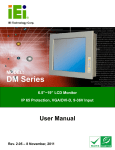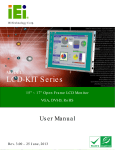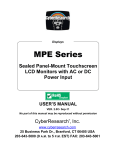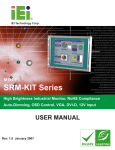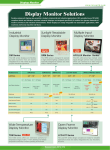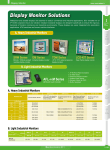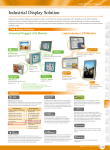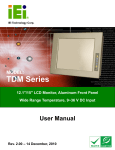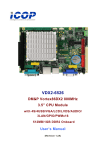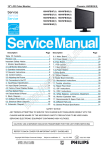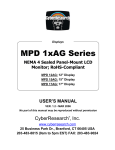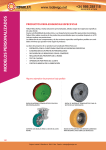Download LCD-KIT_UMN_v2.02
Transcript
LCD-KIT IEI Technology Corp. MODEL: LCD-KIT Series 6.5" ~ 19" Open Frame LCD Monitor OSD Controls, VGA, DVI-D, 12 V Input User Manual Page i Rev. 2.02 – 18 February, 2011 LCD-KIT Revision Date Version Changes 18 February, 2011 2.02 Updated dimension drawings 15 December, 2010 2.01 Modified AV-6600 AD board information Modified Chapter 6 OSD Controls Modified Chapter 7 Software Driver 17 June, 2010 2.00 Updated for LCD-KIT-R20 series 30 September, 2009 1.13 Changed CN11 and CN12 pin definitions 20 July, 2009 1.12 Updated OSD chapter 31 May 2007 1.11 AV-5300 AD Board CN25 connector pin 3 voltage changed to +9V~+36V input 30 April 2007 1.10 Updated Figure 1-4 and Section 4.4 for AV-5300 AD Board V2.0 31 November 2006 Page ii 1.00 Initial release LCD-KIT Copyright COPYRIGHT NOTICE The information in this document is subject to change without prior notice in order to improve reliability, design and function and does not represent a commitment on the part of the manufacturer. In no event will the manufacturer be liable for direct, indirect, special, incidental, or consequential damages arising out of the use or inability to use the product or documentation, even if advised of the possibility of such damages. This document contains proprietary information protected by copyright. All rights are reserved. No part of this manual may be reproduced by any mechanical, electronic, or other means in any form without prior written permission of the manufacturer. TRADEMARKS All registered trademarks and product names mentioned herein are used for identification purposes only and may be trademarks and/or registered trademarks of their respective owners. Page iii LCD-KIT Table of Contents 1 INTRODUCTION.......................................................................................................... 1 1.1 LCD-KIT SERIES LCD MONITOR OVERVIEW ............................................................ 2 1.1.1 Standard Features .............................................................................................. 2 1.1.2 Model Variations ................................................................................................ 2 1.2 APPLICATIONS AND FEATURES .................................................................................... 3 1.2.1 LCD-KIT Series LCD Monitor Applications ..................................................... 3 1.2.2 LCD-KIT Series LCD Monitor Features............................................................ 3 1.3 EXTERNAL OVERVIEW ................................................................................................ 3 1.3.1 Front View .......................................................................................................... 3 1.3.2 Rear View ........................................................................................................... 4 1.3.3 Connectors ......................................................................................................... 5 1.3.4 AD Board ........................................................................................................... 6 1.4 SERIES SPECIFICATIONS .............................................................................................. 7 1.5 CERTIFICATIONS ......................................................................................................... 7 2 MECHANICAL OVERVIEW ...................................................................................... 8 2.1 INTRODUCTION........................................................................................................... 9 2.2 REAR PANEL ............................................................................................................... 9 2.2.1 Rear Panel Variants ........................................................................................... 9 2.2.2 Rear Panel Variant 1.......................................................................................... 9 2.2.3 Rear Panel Variant 2........................................................................................ 10 2.3 CONNECTOR PANEL ...................................................................................................11 2.3.1 Available Connectors ........................................................................................11 2.3.2 Variant 1 Connectors ........................................................................................11 2.3.3 Variant 2 Connectors ........................................................................................11 2.3.4 Variant 3 Connectors ........................................................................................11 2.3.5 Variant 4 Connectors ....................................................................................... 12 2.4 PHYSICAL DIMENSIONS ............................................................................................ 12 2.4.1 General Physical Dimensions.......................................................................... 12 2.4.2 LCD-KIT190G Physical Dimensions............................................................... 13 2.4.3 LCD-KIT170GS Physical Dimensions............................................................. 14 Page iv LCD-KIT 2.4.4 LCD-KIT150G Physical Dimensions............................................................... 15 2.4.5 LCD-KIT121G/GX Physical Dimensions ........................................................ 16 2.4.6 LCD-KIT104GH Physical Dimensions............................................................ 17 2.4.7 LCD-KIT84GH Physical Dimensions.............................................................. 18 2.4.8 LCD-KIT65GH Physical Dimensions.............................................................. 19 2.5 MOUNTING OPTIONS ................................................................................................ 20 3 LCD SPECIFICATIONS ............................................................................................ 21 3.1 LCD SPECIFICATIONS ............................................................................................... 22 3.1.1 LCD Overview ................................................................................................. 22 3.1.2 LCD-KIT190G LCD Specifications ................................................................. 23 3.1.3 LCD-KIT170G LCD Specifications ................................................................. 24 3.1.4 LCD-KIT150G LCD Specifications ................................................................. 25 3.1.5 LCD-KIT121GX LCD Specifications............................................................... 26 3.1.6 LCD-KIT121G LCD Specifications ................................................................. 27 3.1.7 LCD-KIT104GH LCD Specifications .............................................................. 28 3.1.8 LCD-KIT84GH LCD Specifications ................................................................ 29 3.1.9 LCD-KIT65GH LCD Specifications ................................................................ 30 3.2 POWER ADAPTERS .................................................................................................... 31 4 AD BOARDS ................................................................................................................ 32 4.1 AD BOARD OVERVIEW ............................................................................................. 33 4.2 AV-9650 AD BOARD OVERVIEW .............................................................................. 33 4.2.1 AV-9650 Peripheral Interface Connectors....................................................... 34 4.2.2 AV-9650 Rear Panel Connectors ..................................................................... 34 4.3 AV-6650 AD BOARD OVERVIEW .............................................................................. 35 4.3.1 AV-6650 Peripheral Interface Connectors....................................................... 36 4.3.2 AV-6650 Rear Panel Connectors ..................................................................... 36 4.4 AV-6600 AD BOARD OVERVIEW .............................................................................. 36 4.4.1 AV-6600 Peripheral Interface Connectors....................................................... 37 4.4.2 AV-6600 Rear Panel Connectors ..................................................................... 38 5 INSTALLATION ......................................................................................................... 39 5.1 INSTALLATION PRECAUTIONS ................................................................................... 40 5.2 UNPACKING .............................................................................................................. 41 5.2.1 Packaging ........................................................................................................ 41 Page v LCD-KIT 5.2.2 Unpacking Procedure ...................................................................................... 41 5.2.3 Packing List ..................................................................................................... 42 5.3 PRE-INSTALLATION PREPARATION ............................................................................ 42 5.3.1 Tools ................................................................................................................. 42 5.4 CONNECTORS ........................................................................................................... 43 5.4.1 VGA Connector ................................................................................................ 43 5.4.2 DVI-D Connector............................................................................................. 43 5.4.3 12V Power Connector...................................................................................... 44 5.5 MOUNTING THE LCD-KIT SERIES LCD MONITOR .................................................. 44 6 OSD CONTROLS........................................................................................................ 45 6.1 USER MODE OSD STRUCTURE ................................................................................. 46 6.1.1 OSD Buttons..................................................................................................... 46 6.1.2 OSD Menu Structure ........................................................................................ 47 6.2 USING THE OSD....................................................................................................... 48 6.2.1 Main Display Features..................................................................................... 48 6.2.2 Color ................................................................................................................ 49 6.2.3 OSD Configurations......................................................................................... 50 7 SOFTWARE DRIVER ................................................................................................ 51 7.1 INTRODUCTION......................................................................................................... 52 7.2 RS-232 OR USB TOUCH SCREEN ............................................................................. 52 7.3 TOUCH PANEL DRIVER INSTALLATION ...................................................................... 53 7.4 CHANGE THE TOUCH SCREEN INTERFACE ................................................................ 56 7.5 CALIBRATING THE TOUCH SCREEN ........................................................................... 56 A CERTIFICATIONS .................................................................................................... 59 A.1 ROHS COMPLIANT .................................................................................................. 60 B SAFETY PRECAUTIONS ......................................................................................... 61 B.1 SAFETY PRECAUTIONS ............................................................................................. 62 B.1.1 General Safety Precautions ............................................................................. 62 B.1.2 Anti-static Precautions .................................................................................... 63 B.2 MAINTENANCE AND CLEANING PRECAUTIONS ........................................................ 63 B.2.1 Maintenance and Cleaning.............................................................................. 63 B.2.2 Cleaning Tools ................................................................................................. 64 Page vi LCD-KIT C SMARTOSD ................................................................................................................ 65 C.1 IEI SMARTOSD QUICK INSTALLATION GUIDE ......................................................... 66 C.2 PRE-INSTALLATION NOTICE ..................................................................................... 66 C.3 SMARTOSD INSTALL ............................................................................................... 67 C.4 SOFTWARE ILLUSTRATION ....................................................................................... 71 C.4.1 Manage Page................................................................................................... 73 C.4.2 EDID Page ...................................................................................................... 74 C.4.3 Image Page...................................................................................................... 75 C.4.4 Display Page (for analog signal) .................................................................... 76 C.4.5 Color Page ...................................................................................................... 77 C.4.6 PIP Page.......................................................................................................... 78 C.4.7 System Page..................................................................................................... 79 C.4.8 About Page ...................................................................................................... 81 C.5 SMARTOSD FAQ ..................................................................................................... 82 C.5.1 Windows 2000 Installation Failure ................................................................. 82 C.5.2 Vista Installation Failure................................................................................. 83 C.5.3 Model Failure.................................................................................................. 84 C.5.4 DCC Port Failure............................................................................................ 84 Page vii LCD-KIT List of Figures Figure 1-1: Typical LCD-KIT Front View .......................................................................................4 Figure 1-2: Typical LCD-KIT Rear View ........................................................................................5 Figure 1-3: Typical LCD-KIT Connectors .....................................................................................5 Figure 1-4: AV-6600 AD Board ......................................................................................................6 Figure 2-1: Rear Panel Variant 1 .................................................................................................10 Figure 2-2: Rear Panel Variant 2 .................................................................................................10 Figure 2-3: LCD-KIT190G Physical Dimensions (millimeters) .................................................13 Figure 2-4: LCD-KIT170G Physical Dimensions (millimeters) .................................................14 Figure 2-5: LCD-KIT150G Physical Dimensions (millimeters) .................................................15 Figure 2-6: LCD-KIT121G/GX Physical Dimensions (millimeters) ...........................................16 Figure 2-7: LCD-KIT104GH Physical Dimensions (millimeters)...............................................17 Figure 2-8: LCD-KIT84GH Physical Dimensions (millimeters).................................................18 Figure 2-9: LCD-KIT65GH Physical Dimensions (millimeters).................................................19 Figure 4-1: AV-9650 AD Board Overview ...................................................................................33 Figure 4-2: AV-6650 AD Board Overview ...................................................................................35 Figure 4-3: AV-6600 AD Board Overview ...................................................................................37 Figure 5-1: VGA Connector .........................................................................................................43 Figure 5-2: DVI-D Connector .......................................................................................................44 Figure 5-3: 12V Power Connector ...............................................................................................44 Figure 6-1: OSD Control Buttons (Except 6.5") .........................................................................46 Figure 6-2: LCD-KIT65 OSD Control Buttons ............................................................................47 Figure 6-3: Main Display Features ..............................................................................................48 Figure 6-4: Color Options ............................................................................................................49 Figure 6-5: OSD Configurations Menu .......................................................................................50 Figure 7-1: Setup Icon ..................................................................................................................53 Figure 7-2: Welcome Screen .......................................................................................................54 Figure 7-3: License Agreement ...................................................................................................54 Figure 7-4: Initiate Install .............................................................................................................55 Figure 7-5: Installation Starts ......................................................................................................55 Figure 7-6: Finish Installation......................................................................................................56 Page viii LCD-KIT Figure 7-7: PenMount Monitor Icon ............................................................................................57 Figure 7-8: PenMount Monitor Popup Menu ..............................................................................57 Figure 7-9: Configuration Screen................................................................................................57 Figure 7-10: Calibration Initiation Screen ..................................................................................58 Figure 7-11: Calibration Screen ..................................................................................................58 Figure C-1: smartOSD Installer ...................................................................................................67 Figure C-2: smartOSD Welcome Screen ....................................................................................68 Figure C-3: smartOSD Folder Select Screen .............................................................................68 Figure C-4: smartOSD Confirm Installation ...............................................................................69 Figure C-5: smartOSD Installation Progress .............................................................................69 Figure C-6: smartOSD Installation Complete ............................................................................70 Figure C-7: smartOSD Desktop Icon ..........................................................................................70 Figure C-8: Manage Page.............................................................................................................73 Figure C-9: EDID Page .................................................................................................................74 Figure C-10: Image Page..............................................................................................................75 Figure C-11: Display Page ...........................................................................................................76 Figure C-12: Color Page...............................................................................................................77 Figure C-13: PIP Page ..................................................................................................................78 Figure C-14: System Page ...........................................................................................................79 Figure C-15: About Page..............................................................................................................81 Figure C-16: DLL Missing ............................................................................................................82 Figure C-17: Windows Vista Error ..............................................................................................83 Figure C-18: Install as Administrator..........................................................................................83 Figure C-19: Firmware Incompatibility .......................................................................................84 Figure C-20: DCC Port Failure.....................................................................................................84 Page ix LCD-KIT List of Tables Table 1-1: LCD-KIT Series Specifications ....................................................................................7 Table 2-1: Rear Panel Variants ......................................................................................................9 Table 2-2: General Physical Dimensions ...................................................................................12 Table 2-3: Mounting Holes...........................................................................................................20 Table 3-1: LCD-KIT190G LCD Specifications.............................................................................23 Table 3-2: LCD-KIT170G LCD Specifications.............................................................................24 Table 3-3: LCD-KIT150G LCD Specifications.............................................................................25 Table 3-4: LCD-KIT121GX LCD Specifications ..........................................................................26 Table 3-5: LCD-KIT121G LCD Specifications.............................................................................27 Table 3-6: LCD-KIT104GH LCD Specifications ..........................................................................28 Table 3-7: LCD-KIT84GH LCD Specifications ............................................................................29 Table 3-8: LCD-KIT65GH LCD Specifications ............................................................................30 Table 3-9: Power Adapter Specifications ...................................................................................31 Table 4-1: AV-9650 Peripheral Interface Connectors................................................................34 Table 4-2: AV-9650 Rear Panel Connectors...............................................................................34 Table 4-3: AV-6650 Peripheral Interface Connectors................................................................36 Table 4-4: AV-6650 Rear Panel Connectors...............................................................................36 Table 4-5: AV-6600 Peripheral Interface Connectors................................................................38 Table 4-6: AV-6600 Rear Panel Connectors...............................................................................38 Table 5-1: Rear Panel Connectors ..............................................................................................43 Table 5-2: VGA Connector Pinouts.............................................................................................43 Table 5-3: DVI-D Connector Pinouts...........................................................................................44 Table 6-1: OSD Menus..................................................................................................................48 Table C-1: SmartOSD Menu Structure........................................................................................72 Page x LCD-KIT Chapter 1 1 Introduction Page 1 LCD-KIT 1.1 LCD-KIT Series LCD Monitor Overview The LCD-KIT series LCD monitor is the latest member of IEI’s line of sophisticated LCD designs, and it has been improved to be RoHS compliant. It is designed to fit industrial automation, or any other applications that require minimum installation space and flexible configuration. Flexible analog or digital interfaces are provided for ease of connection with a management computer. If remote/non-attentive control is preferred, RS-232 or USB interfaces can be used with customized adapter cables. 1.1.1 Standard Features All the base models listed in Section 1.2.1 have the following standard features LCD monitor OSD controls VGA Robust metal chassis RoHS compliant 1.1.2 Model Variations The LCD-KIT series offers the following model variations. Page 2 LCD-KIT65GH: 6.5” TFT LCD LCD-KIT84GH: 8.4” TFT LCD LCD-KIT84GHM: 8.4” TFT LCD, 9~36 V DC power input LCD-KIT104GH: 10.4” TFT LCD LCD-KIT104GHM: 10.4” TFT LCD, 9~36 V DC power input LCD-KIT121G: 12.1” TFT LCD LCD-KIT121GM: 12.1” TFT LCD, 9~36 V DC power input LCD-KIT121GX: 12.1” TFT LCD LCD-KIT121GXM: 12.1” TFT LCD, 9~36 V DC power input LCD-KIT150G: 15” TFT LCD LCD-KIT150GM: 15” TFT LCD, 9~36 V DC power input LCD-KIT170GM: 17” TFT LCD, 9~36 V DC power input LCD-KIT170GS: 17” TFT LCD LCD-KIT190G: 19” TFT LCD LCD-KIT LCD-KIT190GM: 19” TFT LCD, 9~36 V DC power input 1.2 Applications and Features 1.2.1 LCD-KIT Series LCD Monitor Applications IEI’s series of LCD monitors are designed for system manufacturers, integrators, or value-added resellers that want to provide all the performance, quality and reliability of an LCD display solution at a cost effective price. IEI’s LCD kits offer additional components such as cables, an inverter and power supply with controller interfaces that include VGA and DVI. 1.2.2 LCD-KIT Series LCD Monitor Features Some of the features of the LCD-KIT series LCD monitor include: Analog VGA interface supports most general system boards Over 300 cd/m2 high brightness and 50,000 hrs MTFB long lifetime panel Advanced thermal and air-flow design Supports panel mounting 12 V DC power input via adapter M models have 9~36 V DC power connector Long product life support RoHS compliant 1.3 External Overview The following sections describe the physical layout of the LCD-KIT series LCD monitors. 1.3.1 Front View The front of the LCD-KIT series LCD monitor is a flat panel TFT LCD screen attached to a metal chassis. Figure 1-1 shows a typical LCD-KIT front view. 3 Page 3 LCD-KIT Figure 1-1: Typical LCD-KIT Front View 1.3.2 Rear View The rear of the LCD-KIT series LCD monitor is a metal chassis. An on screen display (OSD) control button panel, if present, is located vertically on the left side of the chassis with the following control buttons: LCD On/Off Auto Left Right Menu The OSD panel also has one power LED. Figure 1-2 shows a typical LCD-KIT rear panel. 3 Page 4 LCD-KIT Figure 1-2: Typical LCD-KIT Rear View 1.3.3 Connectors Each LCD-KIT series LCD monitor has a number of interface connectors on either the top or right panel of the chassis (when viewing the rear panel). Figure 1-3 shows a typical 3 LCD-KIT connector panel. Each model may include or exclude additional connectors. Refer to Section 2.3 for listings of LCD-KITs and their connectors. All connectors are fully 3 described in Section 5.4. 3 Figure 1-3: Typical LCD-KIT Connectors Page 5 LCD-KIT 1.3.4 AD Board The LCD-KIT series LCD monitor AD boards provide a wide variety of control interfaces, receiving and managing signals from a CPU card through cabling. Figure 1-4 shows the 3 AV-6600 AD board as a sample of a typical AD board for the LCD-KIT series LCD monitor. Refer to Chapter 4 for a complete description of AD boards and their connectors. 3 Figure 1-4: AV-6600 AD Board Page 6 LCD-KIT 1.4 Series Specifications The table below shows the LCD-KIT Series specifications. LCD-KIT 65GH LCD Type 84GH 6.5" TFT 8.4" TFT Input Interface 104GH 121G 121GX 10.4" TFT 12.1" TFT 12.1” TFT VGA 15" TFT 170G 190G 17" TFT 19" TFT VGA + DVI-D 640x480 Max. 150G 800x600 1024x768 1280x1024 Resolution Backlight MTBF 50,000 Hrs Contrast 600:1 700:1 LCD Color 800:1 262K 700 Brightness 450 400 1000:1 16.2M 450 500 350 300 (cd/m2) AD Board AV-9650 AV-6650 AV-6600 36W 63000-FSP036RAB610-R Power 50W TBD Adapter Chassis Heavy-duty steel 160/140 View Angle 160/160 140/125 170/160 (H / V) OSD function Yes Mounting Panel Dimensions 203 x 234 x 242.2 x 294 x 294 x 364.1 x 390.4 x 427.9 x (WxHxD) (mm) 121 x 147 x 209 x 240.7 x 240.7 x 262.5 x 300 x 327.4 x 34 35.3 33.6 42 42 41.9 46.9 48.4 -10°C ~ 50°C Operating Temperature Table 1-1: LCD-KIT Series Specifications 1.5 Certifications All LCD-KIT series LCD monitor models comply with the following international standards: RoHS For a more detailed description of these standards, please refer to Appendix A. Page 7 LCD-KIT Chapter 2 2 Mechanical Overview Page 8 LCD-KIT 2.1 Introduction This chapter describes the general mechanical overview of the LCD-KIT series LCD monitors including rear panel variations, available interfaces and overall dimensions. 2.2 Rear Panel The rear panel of the LCD-KIT series LCD monitor is comprised of a metal chassis with an OSD control panel. 2.2.1 Rear Panel Variants Table 2-1 shows the rear panel variants for the LCD-KIT series LCD monitor. 3 Variant Model OSD Control Panel Location Number LCD-KIT190G LCD-KIT170G LCD-KIT150G LCD-KIT121GX LCD-KIT121G Vertically along the left side of the rear panel. 1 LCD-KIT104GH LCD-KIT84GH LCD-KIT65GH In line along the bottom of the rear panel. 2 Table 2-1: Rear Panel Variants 2.2.2 Rear Panel Variant 1 The following models of the LCD-KIT series LCD monitor have an OSD control panel located vertically along the left side of the rear panel: LCD-KIT190G LCD-KIT170G LCD-KIT150G LCD-KIT121GX LCD-KIT121G Page 9 LCD-KIT LCD-KIT104GH LCD-KIT84GH Figure 2-1 shows the location of the rear panel variant 1 OSD controls. 3 Figure 2-1: Rear Panel Variant 1 2.2.3 Rear Panel Variant 2 The following model of the LCD-KIT series LCD monitor has OSD control buttons located on the bottom of the rear panel: LCD-KIT65GH Figure 2-2 shows the location of the rear panel variant 2 OSD controls. 3 Figure 2-2: Rear Panel Variant 2 Page 10 LCD-KIT 2.3 Connector Panel All external peripheral interface connectors are located on the rear panel of the LCD-KIT series LCD monitor. The following sections describe the rear panel variants and their associated connectors. 2.3.1 Available Connectors There are a number of rear panel peripheral device connectors available for the LCD-KIT series LCD monitor. VGA connector DVI-D connector 12 V DC power connector 9~36 V DC power connector 2.3.2 Variant 1 Connectors The following is a list of the bottom panel peripheral device connectors used on the LCD-KIT65GH, LCD-KIT84GH and LCD-KIT104GH series LCD monitor. VGA connector 12 V DC power connector 2.3.3 Variant 2 Connectors The following is a list of the bottom panel peripheral device connectors used on the LCD-KIT121GX, LCD-KIT150G, LCD-KIT170GS and LCD-KIT190G series LCD monitor. VGA connector DVI-D connector 12 V DC power connector 2.3.4 Variant 3 Connectors The following is a list of the bottom panel peripheral device connectors used on the LCD-KIT84GHM and LCD-KIT104GHM series LCD monitor. VGA connector Page 11 LCD-KIT 9~36 V DC power connector 2.3.5 Variant 4 Connectors The following is a list of the bottom panel peripheral device connectors used on the LCD-KIT121GXM, LCD-KIT150GM, LCD-KIT170GM and LCD-KIT190GM series LCD monitor. VGA connector DVI-D connector 9~36 V DC power connector 2.4 Physical Dimensions The following sections describe the physical dimensions for each model of the LCD-KIT series LCD monitor. 2.4.1 General Physical Dimensions General physical dimensions for the LCD-KIT series LCD monitors are shown in Table 3 2-2. Model Width (mm) Height (mm) Depth (mm) LCD-KIT190G 427.9 327.0 48.7 LCD-KIT170GS 390.4 299.6 46.3 LCD-KIT150G 364.1 262.1 41.3 LCD-KIT121G/GX 294.0 240.7 41.3 LCD-KIT104GH 244.5 209.0 43.4 LCD-KIT84GH 234.0 147.0 44.0 LCD-KIT65GH 203.4 121.0 34.0 Table 2-2: General Physical Dimensions Page 12 LCD-KIT 2.4.2 LCD-KIT190G Physical Dimensions The physical dimensions of the LCD-KIT190G are shown in Figure 2-3. 3 Figure 2-3: LCD-KIT190G Physical Dimensions (millimeters) Page 13 LCD-KIT 2.4.3 LCD-KIT170GS Physical Dimensions The physical dimensions of the LCD-KIT170GS are shown in Figure 2-4. 3 Figure 2-4: LCD-KIT170G Physical Dimensions (millimeters) Page 14 LCD-KIT 2.4.4 LCD-KIT150G Physical Dimensions The physical dimensions of the LCD-KIT150G are shown in Figure 2-5. 3 Figure 2-5: LCD-KIT150G Physical Dimensions (millimeters) Page 15 LCD-KIT 2.4.5 LCD-KIT121G/GX Physical Dimensions The physical dimensions of the LCD-KIT121G/GX are shown in Figure 2-6. 3 Figure 2-6: LCD-KIT121G/GX Physical Dimensions (millimeters) Page 16 LCD-KIT 2.4.6 LCD-KIT104GH Physical Dimensions The physical dimensions of the LCD-KIT104GH are shown in Figure 2-7. 3 Figure 2-7: LCD-KIT104GH Physical Dimensions (millimeters) Page 17 LCD-KIT 2.4.7 LCD-KIT84GH Physical Dimensions The physical dimensions of the LCD-KIT84GH are shown in Figure 2-8. 4 Figure 2-8: LCD-KIT84GH Physical Dimensions (millimeters) Page 18 LCD-KIT 2.4.8 LCD-KIT65GH Physical Dimensions The physical dimensions of the LCD-KIT65GH are shown in Figure 2-9. 4 Figure 2-9: LCD-KIT65GH Physical Dimensions (millimeters) Page 19 LCD-KIT 2.5 Mounting Options Each LCD-KIT series LCD monitor has mounting holes located on the mounting bracket. Table 2-3 details the number of mounting holes for each model of the LCD-KIT series LCD 4 monitor. Refer to Section 2.4 for more information. 4 Model No. of Round Holes - Size No. of Slotted Holes LCD-KIT190G 6 – 4 mm diameter 8 LCD-KIT170G 6 – 4.5 mm diameter 8 LCD-KIT150G 6 – 4.5 mm diameter 8 LCD-KIT121G/GX 4 – 3.5 mm diameter - LCD-KIT104GH 4 – 3.5 mm diameter - LCD-KIT84GH 4 – 3.5 mm diameter 4 LCD-KIT65GH 4 – 3.5 mm diameter 4 Table 2-3: Mounting Holes Page 20 LCD-KIT Chapter 3 3 LCD Specifications Page 21 LCD-KIT 3.1 LCD Specifications 3.1.1 LCD Overview The LCD-KIT series industrial LCD monitors use the following LCD panels. LCD-KIT190G: HANNSTAR/HSD190MEN3-A LCD-KIT170G: AUO G170EG01 V0 LCD-KIT150G: AUO G150XG01 V1 LCD-KIT121GX: AUO G121XN01 V0 LCD-KIT121G: AUO G121SN01 V4 LCD-KIT104GH: AUO/G104SN02 V2 LCD-KIT084GH: AUO/G084SN05 V8 LCD-KIT65GH: AUO/G065VN01 V2 Detailed specifications for the LCD screens are listed in the following sections. Page 22 LCD-KIT 3.1.2 LCD-KIT190G LCD Specifications The table below lists the LCD-KIT190G LCD specifications. Model LCD-KIT190G Size 19” HANNSTAR/HSD190MEN3 MFR/Model -A Resolution SXGA (1280 x 1024) Active Area (mm) 376.32 x 301.06 Pixel Pitch (mm) 0.294 Mode TN Number of Colors 16.7M Color Saturation (NTSC%) 72 View Angle (H/V) 170 / 160 Brightness (cd/m2) 300 Contrast Ratio 1000:1 Response Time (ms) (at 25C) 5 Interface 2ch LVDS Supply Voltage (V) 5 Backlight 4 CCFL Table 3-1: LCD-KIT190G LCD Specifications Page 23 LCD-KIT 3.1.3 LCD-KIT170G LCD Specifications The table below lists the LCD-KIT170G LCD specifications. Model LCD-KIT170G Size 17” MFR/Model AUO/G170EG01 V0 Resolution SXGA (1280 x 1024) Active Area (mm) 337.9 x 270.3 Pixel Pitch (mm) 0.264 Mode TN Number of Colors 16.7M Color Saturation (NTSC%) 72 View Angle (H/V) 170/160 Brightness (cd/m2) 350 Contrast Ratio 800:1 Response Time (ms) (at 25C) 8 Power Consumption (W) 25.2 Interface 2ch LVDS Supply Voltage (V) 5 Backlight 4 CCFL Lamp Life (hrs) 50,000 Table 3-2: LCD-KIT170G LCD Specifications Page 24 LCD-KIT 3.1.4 LCD-KIT150G LCD Specifications The table below lists the LCD-KIT150G LCD specifications. Model LCD-KIT150G Size 15” AUO/G150XG01 MFR/Model V1 XGA (1024 x Resolution 768) Active Area (mm) 304.1 x 228.1 Pixel Pitch (mm) 0.297 Mode TN Number of Colors 16.2M Color Saturation (NTSC%) 65 View Angle (H/V) 140/120 Brightness (cd/m2) 350 Contrast Ratio 700:1 Response Time (ms) (at 25C) 8 Power Consumption (W) 8.9 Interface 1ch LVDS Supply Voltage (V) 3.3 Backlight 2 CCFL Lamp Life (hrs) 50000 Table 3-3: LCD-KIT150G LCD Specifications Page 25 LCD-KIT 3.1.5 LCD-KIT121GX LCD Specifications The table below lists the LCD-KIT121GX LCD specifications. Model LCD-KIT121GX Size 12.1” MFR/Model AUO/G121XN01 V0 Resolution SVGA (1024 x 768) Active Area (mm) 245.76 x 184.32 Pixel Pitch (mm) 0.3075 Mode TN Number of Colors 262K View Angle (H/V) 160/160 Brightness (cd/m2) 500 Contrast Ratio 700:1 Response Time (ms) (at 25C) 35 Power Consumption (W) 9.15 Interface 1ch LVDS Supply Voltage (V) 3.3 Backlight LED Color Saturation (NTSC%) 70 Table 3-4: LCD-KIT121GX LCD Specifications Page 26 LCD-KIT 3.1.6 LCD-KIT121G LCD Specifications The table below lists the LCD-KIT121G LCD specifications. Model LCD-KIT121G Size 12.1” MFR/Model AUO/G121SN01 V4 Resolution SVGA (800 x 600) Active Area (mm) 245.76 x 184.32 Pixel Pitch (mm) 0.3075 Mode TN Number of Colors 262K View Angle (H/V) 160/140 Brightness (cd/m2) 450 Contrast Ratio 700:1 Response Time (ms) (at 25C) 35 Power Consumption (W) 6.7 Interface 1ch LVDS Supply Voltage (V) 3.3 Backlight LED Color Saturation (NTSC%) 55 Table 3-5: LCD-KIT121G LCD Specifications Page 27 LCD-KIT 3.1.7 LCD-KIT104GH LCD Specifications The table below lists the LCD-KIT104GH LCD specifications. Model LCD-KIT104GH Size 10.4” MFR/Model AUO/G104SN02 V2 Resolution SVGA (800 x 600) Active Area (mm) 211.2 x 158.4 Pixel Pitch (mm) 0.264 Mode TN Number of Colors 262K View Angle (H/V) 160 / 140 Brightness (cd/m2) 400 Contrast Ratio 700:1 Response Time (ms) (at 25C) 30 Power Consumption (W) 5.2 Interface 1ch LVDS Supply Voltage (V) 3.3 Backlight LED Color Saturation (NTSC%) 45 Table 3-6: LCD-KIT104GH LCD Specifications Page 28 LCD-KIT 3.1.8 LCD-KIT84GH LCD Specifications The table below lists the LCD-KIT84GH LCD specifications. Model LCD-KIT84GH Size 8.4” MFR/Model AUO/G084SN05 V8 Resolution SVGA (800 x 600) Active Area (mm) 170.4 x 127.8 Pixel Pitch (mm) 0.213 Mode TN Number of Colors 262K View Angle (H/V) 160 / 140 Brightness (cd/m2) 450 Contrast Ratio 600:1 Response Time (ms) (at 25C) 30 Power Consumption (W) 4.2 Interface LVDS Supply Voltage (V) 3.3 Backlight LED Color Saturation (NTSC%) 45 Table 3-7: LCD-KIT84GH LCD Specifications Page 29 LCD-KIT 3.1.9 LCD-KIT65GH LCD Specifications The table below lists the LCD-KIT65GH LCD specifications. Model LCD-KIT65GH Size 6.5” MFR/Model AUO/G065VN01 V2 Resolution VGA (640 x 480) Active Area (mm) 132.48 x 99.36 Pixel Pitch (mm) 0.207 Mode TN Number of Colors 262K Color Saturation (NTSC%) 55 View Angle (H/V) 160/140 Brightness (cd/m2) 800 Contrast Ratio 600:1 Response Time (ms) (at 25C) 25 Power Consumption (W) 3.86 Interface LVDS Supply Voltage (V) 3.3 Backlight LED Table 3-8: LCD-KIT65GH LCD Specifications Page 30 LCD-KIT 3.2 Power Adapters Table 3-9 lists the AC/DC power adapter specifications. 4 LCD-KIT 190G, 170G, 150G, 121G/XG 104GH, 84GH, 65GH Power 50 Watt AC/DC Adapter 35 Watt AC/DC Adapter General Description Universal Input 90 to 264 VAC Universal Input 90 to 264 VAC EMI Meets FCC/CISPR 22 Class B EMI Meets FCC/CISPR 22 Class B MTBF 165Khrs MTBF 300Khrs Limited Power Source Limited Power Source Input Voltage Range 90-264VAC 90-264VAC Input Frequency 47-63 Hz 47-63 Hz Inrush Current 40A max. (Cold Start) 30A max. (Cold Start) Hold-up Time 10mS typical 10mS typical Leakage Current 0.5mA max. 3.5mA max. Short Circuit Protection Continuous Continuous Over-voltage Protection Yes Yes Continuous Output Power 50W max. 35W max. Hi-pot Isolation: 4242VDC 4242VDC Input / Output Table 3-9: Power Adapter Specifications Page 31 LCD-KIT Chapter 4 4 AD Boards Page 32 LCD-KIT 4.1 AD Board Overview The LCD-KIT series industrial LCD monitor AD board provides a wide variety of control interfaces, receiving and managing interface signals from a CPU card through cabling. There are three AD boards used for the LCD-KIT series LCD monitors: AV-9650, AV-6650 and AV-6600. Refer to Section 1.4 for a listing of LCD-KIT series LCD monitors and their 4 associated AD board. The following sections describe each AD board in detail. 4.2 AV-9650 AD Board Overview Figure 4-1: AV-9650 AD Board Overview Page 33 LCD-KIT 4.2.1 AV-9650 Peripheral Interface Connectors Table 4-1 shows a list of the peripheral interface connectors on the AV-9650 AD board. 4 Connector Type Label Auto-dimming connector 6-pin wafer connector CN7 Backlight Inverter connector 4-pin wafer connector CN16 Debug port connector 4-pin wafer connector CN9 9-pin wafer connector CN10 LVDS connector 30-pin crimp connector CN15 Power input connector 3-pin connector CN2 Power output connector 2-pin wafer connector CN4 USB signal input connector 4-pin wafer connector CN17 Touchscreen connector 9-pin wafer connector J4 VGA connector 10-pin box header CN14 External OSD and LED indication connector Table 4-1: AV-9650 Peripheral Interface Connectors 4.2.2 AV-9650 Rear Panel Connectors Table 4-2 lists the rear panel connectors and buttons on the AV-9650 AD board. 4 Connector Type Label DC 12V power connector DC Power Jack CN13 Serial port connector RS-232 connector J7 OSD function button Pushbutton S1 OSD function button Pushbutton S2 OSD function button Pushbutton S3 OSD function button Pushbutton S4 VGA connector 15-pin VGA connector VGA1 Table 4-2: AV-9650 Rear Panel Connectors Page 34 LCD-KIT 4.3 AV-6650 AD Board Overview Figure 4-2: AV-6650 AD Board Overview Page 35 LCD-KIT 4.3.1 AV-6650 Peripheral Interface Connectors Table 4-3 shows a list of the peripheral interface connectors on the AV-6650 AD board. 4 Connector Type Label Auto-dimming connector 6-pin wafer connector CN7 Backlight inverter connector 6-pin wafer connector CN6 Debug port connector 4-pin wafer connector CN9 9-pin wafer connector CN10 LVDS output connector 30-pin connector CN5 Power output connector 2-pin header CN4 Power input connector 3-pin connector CN2 12-pin wafer connector CN14 Touchscreen connector 9-pin wafer connector J4 VGA connector 10-pin box header VGA2 External OSD and LED indication connector RS-232 and USB signal input connector Table 4-3: AV-6650 Peripheral Interface Connectors 4.3.2 AV-6650 Rear Panel Connectors Table 4-4 lists the rear panel connectors and jumpers on the AV-6650 AD board. 4 Connector Type Label DC 12V power connector DC Power Jack CN13 VGA connector 15-pin VGA connector VGA1 Table 4-4: AV-6650 Rear Panel Connectors 4.4 AV-6600 AD Board Overview The AV-6600 AD board provides a wide variety of control interfaces, receiving and managing interface signals from a CPU card through cabling. The following sections describe the AV-6600 AD board in detail. Page 36 LCD-KIT Figure 4-3: AV-6600 AD Board Overview 4.4.1 AV-6600 Peripheral Interface Connectors Table 4-5 shows a list of the peripheral interface connectors on the AV-6600 AD board. 4 Connector Type Label Audio input connector 4-pin wafer connector CN11 Audio speaker output connector 4-pin wafer connector CN12 Auto-dimming connector 6-pin wafer connector CN7 Debug connector 4-pin wafer connector CN9 External OSD and LED indication connector 9-pin wafer connector CN10 Page 37 LCD-KIT Infrared connector 6-pin wafer connector CN8 Inverter interface connector 6-pin wafer connector CN6 LVDS connector 30-pin connector CN5 Power output connector (+12 V) 2-pin wafer connector CN3 Power output connector (+5 V) 2-pin wafer connector CN4 Power input connector 3-pin connector CN2 RS-232 and USB signal input connector 12-pin wafer connector CN14 Touchscreen connector 9-pin wafer connector J4 VGA connector 10-pin box header VGA2 Table 4-5: AV-6600 Peripheral Interface Connectors 4.4.2 AV-6600 Rear Panel Connectors Table 4-6 lists the rear panel connectors on the AV-6600 AD board. 4 Connector Type Label 12V DC power connector DC Power Jack CN13 DVI connector 24-pin DVI-D connector J2 VGA connector 15-pin VGA connector VGA1 Table 4-6: AV-6600 Rear Panel Connectors Page 38 LCD-KIT Chapter 5 5 Installation Page 39 LCD-KIT 5.1 Installation Precautions When installing the LCD-KIT series LCD monitor, please follow the precautions listed below: Read the user manual: The user manual provides a complete description of the LCD-KIT series LCD monitor, installation instructions and configuration options. DANGER! Disconnect Power: Power to the LCD monitor must be disconnected when installing the LCD-KIT series LCD monitor, or before any attempt is made to access the rear panel. Electric shock and personal injury might occur if the rear panel of the monitor is opened while the power cord is still connected to an electrical outlet. Qualified Personnel: The LCD-KIT series LCD monitor must be installed and operated only by trained and qualified personnel. Maintenance, upgrades, or repairs may only be carried out by qualified personnel who are familiar with the associated dangers. Mounting: Since the monitor may weigh up to 10 kg (not including a swing arm or other accessories), please ensure at least two people assist with mounting the monitor. Air Circulation: Make sure there is sufficient air circulation when installing the monitor. The monitor’s cooling vents must not be obstructed by any objects. Blocking the vents can cause overheating of the monitor. Leave at least 5 cm of clearance around the monitor to prevent overheating. Grounding: The monitor should be properly grounded. The voltage feeds must not be overloaded. Adjust the cabling and provide external overcharge protection per the electrical values indicated on the label attached to the back of the monitor. Anti-static Discharge: The rear panel of the monitor must to be removed to configure the monitor’s AD board voltage select jumper. When doing so, be sure the monitor is disconnected from its power source and take all necessary safety precautions to avoid electrocution and static discharge to the AD board. The use of a grounded wrist strap and an anti-static work pad is recommended. Page 40 LCD-KIT 5.2 Unpacking 5.2.1 Packaging When shipped, the LCD-KIT series LCD monitor is wrapped in a plastic bag. Two polystyrene ends are placed on either side of the monitor. The monitor is then placed into a first (internal) cardboard box. This box is then sealed and placed into a second (external) cardboard box. The second box is also sealed. A bag containing accessory items is placed with the monitor in the internal (first) box. 5.2.2 Unpacking Procedure To unpack the LCD-KIT series LCD monitor, follow the steps below: WARNING: The front side LCD screen has a protective plastic cover stuck to the screen. Only remove the plastic cover after the LCD-KIT series LCD monitor has been properly installed. This ensures the screen is protected during the installation process. Step 1: Use box cutters, a knife or a sharp pair of scissors that seals the top side of the external (second) box. Step 2: Open the external (second) box. Step 3: Use box cutters, a knife or a sharp pair of scissors that seals the top side of the internal (first) box. Step 4: Lift the monitor out of the boxes. Step 5: Remove both polystyrene ends, one from each side. Step 6: Pull the plastic cover off the LCD-KIT series LCD monitor. Step 7: Make sure all the components listed in the packing list are present. Step 0: Page 41 LCD-KIT 5.2.3 Packing List All the monitors in the LCD-KIT series are shipped with the following components: 1 x LCD-KIT series LCD monitor. 1 x AC Power cable 1 x VGA Cable 1 x 50W AC Power Adapter (LCD-KIT190G / 170 / 150 / 121) 1 x 35W AC Power Adapter (LCD-KIT104GH / 84 / 65) 5 x Replacement Round Head Screw 5 x Replacement Flat Head Screw 5 x Replacement Wire Strain Band 1 x User Manual on CDROM If any of these items are missing or damaged, contact the distributor or sales representative immediately. 5.3 Pre-installation Preparation 5.3.1 Tools Before installing the LCD-KIT series LCD monitor, make sure the following tools are on hand: Philips (crosshead) screwdriver: All the retention screws on the system are Philips screws. Soft working mat: When the LCD-KIT series LCD monitor is installed, the screen is placed on the working surface. It is therefore important to rest the MPC industrial workstation on a soft mat that cannot damage the LCD screen on the front of the LCD-KIT series LCD monitor. Page 42 LCD-KIT 5.4 Connectors Table 5-1 lists the rear panel connectors for the LCD-KIT series LCD monitors. 4 LCD-KIT 65GH DVI-D - VGA Yes Power (12V Jack) Yes 84GH 104GH 121G/GX 150G 170G 190G Yes Table 5-1: Rear Panel Connectors 5.4.1 VGA Connector Use the rear panel standard 15-pin female VGA connector to connect the LCD monitor to the system graphics interface. Pin Description Pin Description Pin Description 1 RED 6 GROUND 11 NC 2 GREEN 7 GROUND 12 DDCDAT 3 BLUE 8 GROUND 13 HSYNC 4 NC 9 NC 14 VSYNC 5 GROUND 10 GROUND 15 DDCCLK Table 5-2: VGA Connector Pinouts Figure 5-1: VGA Connector 5.4.2 DVI-D Connector Use the rear panel standard 24-pin female DVI-D connector to connect the LCD monitor to the system graphics interface. Page 43 LCD-KIT Pin Description Pin Description Pin Description 1 TMDS Data2- 9 TMDS Data1- 17 TMDS Data0- 2 TMDS Data2+ 10 TMDS Data1+ 18 TMDSData0+ 3 TMDS Data2/4 Shield 11 TMDS Data1/3 Shield 19 TMDS Data0/5 Shield 4 TMDS Data4- 12 TMDS Data3- 20 TMDS Data5- 5 TMDS Data4+ 13 TMDS Data3+ 21 TMDS Data5+ 6 DDC Clock [SCL] 14 +5 V Power 22 TMDS Clock Shield 7 DDC Data [SDA] 15 Ground (for +5 V) 23 TMDS Clock + 8 Analog vertical sync 16 Hot Plug Detect 24 TMDS Clock - Table 5-3: DVI-D Connector Pinouts Figure 5-2: DVI-D Connector 5.4.3 12V Power Connector Use the rear panel +12V DC (or 9~36V DC on M models) jack to connect the monitor to a power source. Figure 5-3: 12V Power Connector 5.5 Mounting the LCD-KIT Series LCD Monitor Each LCD-KIT series LCD monitor comes with a preinstalled mounting bracket with a number of holes available for mounting purposes that system integrators will find especially useful. Refer to Sections 2.4 and 2.5 for further details on the number and 4 4 location of mounting holes for each model of the LCD-KIT series LCD monitor. Page 44 LCD-KIT Chapter 6 6 OSD Controls Page 45 LCD-KIT 6.1 User Mode OSD Structure 6.1.1 OSD Buttons There are several on-screen-display (OSD) control buttons oriented either vertically along the right hand side or horizontally along the bottom of the monitor front panel. Refer to Section 2.2 for availability and orientation of the OSD controls on specific LCD-KIT series 4 LCD monitors. Figure 6-1 shows a typical arrangement of OSD controls for all models except the 6.5" 4 model. Figure 6-1: OSD Control Buttons (Except 6.5") Figure 6-2 shows the OSD controls for the 6.5". 4 Page 46 LCD-KIT Figure 6-2: LCD-KIT65 OSD Control Buttons 6.1.2 OSD Menu Structure Table 6-1 shows the OSD menu structure for all models of the SRM series LCD monitor. Level 0 Level 1 Value Main Display Features Menu Brightness 0 to 100 Contrast 0 to 100 Clock 0 to 100 Phase 0 to 100 H. Position 0 to 100 V. Position 0 to 100 Sharpness 1 to 5 6500K - Preset NTSC value 7500K - Preset NTSC value 9300K - Preset NTSC value Red RGB values from 0 to 100 Green RGB values from 0 to 100 Blue RGB values from 0 to 100 OSD Time Out 0 to 60 sec OSD Position 1 to 5 OSD Transparency 20, 40, 60, 80, 100 Color Menu OSD Menu Page 47 LCD-KIT Exit Menu Factory Reset Select Auto Adjust Select Auto Color Select Gamma Off, On Exit Select Table 6-1: OSD Menus 6.2 Using the OSD OSD menu options are described below. 6.2.1 Main Display Features Main display features are shown in Figure 6-3. Figure 6-3: Main Display Features The brightness option adjusts the brightness of screen. This function Brightness adjusts the offset value of ADC. Setting this value too high or too low will affect the quality of image. When the auto- dimming function is turned on, the brightness control is not effective. Contrast Clock Page 48 This function adjusts the gain value of ADC. Adjusting this value too high or too low will worsen the quality of image. Adjusts the width of the display screen. LCD-KIT Phase Adjusts the input signal. H. Position Adjusts the horizontal position of the display screen. V. Position Adjusts the vertical position of the display screen Sharpness Adjust the sharpness of the display 6.2.2 Color Color options are shown in Figure 6-4. Figure 6-4: Color Options The Color menu fine-tunes the palette of color hues for the LCD. 6500k NTSC standard Kelvin 7500k NTSC standard Kelvin 9300k NTSC standard Kelvin User This item allows fine-tuning the balance among Red, Green, and Blue color hues if images look garish or unrealistic. Page 49 LCD-KIT 6.2.3 OSD Configurations The OSD configurations are shown in Figure 6-5. Figure 6-5: OSD Configurations Menu OSD Configurations are described below. OSD Time Out Determines how many seconds the OSD screen stays on screen before it disappears when OSD is left unattended. Adjusts the OSD position on the screen. Position 1 is in the upper left OSD Position of the screen, position 2 in the upper right and position 3 in the center. OSD Transparency Adjust the transparency of the OSD menu background. Factory Reset Restores the default OSD settings. Note that this will restore all default display settings. Auto Adjust Automatically adjusts the position of the display screen Auto Color Automatically adjusts the color settings. Page 50 LCD-KIT Chapter 7 7 Software Driver Page 51 LCD-KIT 7.1 Introduction The touch panel controller enables analog resistive touch panels for four-wire, five-wire & eight-wire models. The controller directly communicates with the PC system through the touch panel communications interface. The controller design is superior in sensitivity, accuracy, and friendly operation. The touch panel driver emulates the left mouse button and the right mouse button functions. The touch panel driver supports the following operating systems: Microsoft® Windows® versions: o o o o o o Microsoft® Windows® 2000 Microsoft® Windows® XP Microsoft® Windows® 2003 Microsoft® Windows® 2008 Microsoft® Windows® Vista Microsoft® Windows® 7 Microsoft® Windows® CE versions: o o o Microsoft® Windows® CE 4.2 Microsoft® Windows® CE 5.0 Microsoft® Windows® CE 6.0 Linux Kernel 2.6 DOS Driver installation is described below. 7.2 RS-232 or USB Touch Screen Before installing the driver, connect the LCD-KIT monitor to the motherboard. The LCD-KIT monitors support touch screen modality through an RS-232 or USB interface connection. Decide through which interface the touch screen is to be controlled. RS-232 Interface: If the touch screen interface connection is an RS-232 connection, connect the RS-232 connector on the single board computer to the DB-9 connector of the LCD-KIT monitor. Page 52 LCD-KIT USB Interface: If the touch screen interface connection is a USB connection, connect the USB connector on the single board computer to the external USB port connector of the LCD-KIT monitor. 7.3 Touch Panel Driver Installation WARNING: Before the touch screen driver is installed, make sure the system is connected to the monitor with a USB cable or an RS-232 null cable. Also, make sure the VGA connector on the system is connected to the VGA connector on the bottom of the monitor. To install the touch panel driver for the LCD-KIT, please follow the instructions below: Step 1: Connect the LCD-KIT monitor to the single board computer. See above. Step 2: Install the driver CD. Install the driver CD into the system to which the LCD-KIT monitor is connected. Step 3: Select the Touch Screen option in the menu of driver CD. The directory in Figure 7-1 appears. Figure 7-1: Setup Icon Page 53 LCD-KIT Step 4: Double click the setup icon in Figure 7-1. Step 5: The Welcome screen in Figure 7-2 appears. Figure 7-2: Welcome Screen Step 6: Click Next to continue. Step 7: The license agreement in Figure 7-3 appears. Accept the terms of the agreement by clicking I Agree. Figure 7-3: License Agreement Page 54 LCD-KIT Step 8: The installation destination screen appears. See Figure 7-4. Click Install. Figure 7-4: Initiate Install Step 9: The installation of the program begins. See Figure 7-5. Figure 7-5: Installation Starts Step 10: When the installation is complete, the complete screen appears. See Figure 7-6. To complete the installation process click Finish. Page 55 LCD-KIT Figure 7-6: Finish Installation 7.4 Change the Touch Screen Interface If the touch screen interface must be changed from an RS-232 interface to a USB interface or, from a USB interface to an RS-232 interface, the following steps must be followed. Step 1: Uninstall the touch screen driver Step 2: Remove the interface cable i.e. remove the RS-232 cable or the USB cable Step 3: Install the new cable i.e. install the USB cable or the RS-232 cable. Step 4: Reinstall the driver CD as described above. Step 0: 7.5 Calibrating the Touch Screen To calibrate the touch screen cursor with the motion of the touch screen pen (or finger), please follow the steps below: Step 1: Make sure the system is properly connected through an RS-232 or a USB interface to the LCD-KIT monitor. Step 2: Make sure the touch screen driver is properly installed. Page 56 LCD-KIT Step 3: Locate the PenMount Monitor icon in the bottom left corner of the screen. Figure 7-7: PenMount Monitor Icon Step 4: Click the icon. A pop up menu appears. See Figure 7-8. Figure 7-8: PenMount Monitor Popup Menu Step 5: Click Control Panel in the pop up menu shown in Figure 7-8. Step 6: The configuration screen in Figure 7-9 appears. Figure 7-9: Configuration Screen Page 57 LCD-KIT Step 7: Double click the PenMount 6000 icon as shown in Figure 7-9. Step 8: The calibration initiation screen in Figure 7-10 appears. Step 9: Select the Standard Calibration button as shown in Figure 7-10. Figure 7-10: Calibration Initiation Screen Step 10: The calibration screen in is shown. See Figure 7-11. Figure 7-11: Calibration Screen Step 11: Follow the instructions. The user is asked touch the screen at five specified points after which the screen is calibrated. Step 0: Page 58 LCD-KIT Appendix A A Certifications Page 59 LCD-KIT A.1 RoHS Compliant All models in the LCD-KIT series comply with the Restriction of Hazardous Materials (RoHS) Directive. This means that all components used to build the industrial workstations and the workstation itself are RoHS compliant. The RoHS Directive bans the placing on the EU market of new electrical and electronic equipment containing more than agreed levels of lead, cadmium, mercury, hexavalent chromium, polybrominated biphenyl (PBB) and polybrominated diphenyl ether (PBDE) flame retardants. Page 60 LCD-KIT Appendix B B Safety Precautions Page 61 LCD-KIT WARNING: The precautions outlined in this chapter should be strictly followed. Failure to follow these precautions may result in permanent damage to the LCD-KIT Series. B.1 Safety Precautions Please follow the safety precautions outlined in the sections that follow: B.1.1 General Safety Precautions Please ensure the following safety precautions are adhered to at all times. Follow the electrostatic precautions outlined below whenever the LCD-KIT Series is opened. Make sure the power is turned off and the power cord is disconnected whenever the LCD-KIT Series is being installed, moved or modified. Do not apply voltage levels that exceed the specified voltage range. Doing so may cause fire and/or an electrical shock. Electric shocks can occur if the LCD-KIT Series chassis is opened when the LCD-KIT Series is running. Do not drop or insert any objects into the ventilation openings of the LCD-KIT Series. If considerable amounts of dust, water, or fluids enter the LCD-KIT Series, turn off the power supply immediately, unplug the power cord, and contact the LCD-KIT Series vendor. DO NOT: o o o o Page 62 Drop the LCD-KIT Series against a hard surface. Strike or exert excessive force onto the LCD panel. Touch any of the LCD panels with a sharp object In a site where the ambient temperature exceeds the rated temperature LCD-KIT B.1.2 Anti-static Precautions WARNING: Failure to take ESD precautions during the installation of the LCD-KIT Series may result in permanent damage to the LCD-KIT Series and severe injury to the user. Electrostatic discharge (ESD) can cause serious damage to electronic components, including the LCD-KIT Series. Dry climates are especially susceptible to ESD. It is therefore critical that whenever the LCD-KIT Series is opened and any of the electrical components are handled, the following anti-static precautions are strictly adhered to. Wear an anti-static wristband: Wearing a simple anti-static wristband can help to prevent ESD from damaging any electrical component. Self-grounding: Before handling any electrical component, touch any grounded conducting material. During the time the electrical component is handled, frequently touch any conducting materials that are connected to the ground. Use an anti-static pad: When configuring or working with an electrical component, place it on an antic-static pad. This reduces the possibility of ESD damage. Only handle the edges of the electrical component: When handling the electrical component, hold the electrical component by its edges. B.2 Maintenance and Cleaning Precautions When maintaining or cleaning the LCD-KIT Series, please follow the guidelines below. B.2.1 Maintenance and Cleaning Prior to cleaning any part or component of the LCD-KIT Series, please read the details below. Page 63 LCD-KIT Except for the LCD panel, never spray or squirt liquids directly onto any other components. To clean the LCD panel, gently wipe it with a piece of soft dry cloth or a slightly moistened cloth. The interior of the LCD-KIT Series does not require cleaning. Keep fluids away from the LCD-KIT Series interior. Be cautious of all small removable components when vacuuming the LCD-KIT Series. Turn the LCD-KIT Series off before cleaning the LCD-KIT Series. Never drop any objects or liquids through the openings of the LCD-KIT Series. Be cautious of any possible allergic reactions to solvents or chemicals used when cleaning the LCD-KIT Series. Avoid eating, drinking and smoking within vicinity of the LCD-KIT Series. B.2.2 Cleaning Tools Some components in the LCD-KIT Series may only be cleaned using a product specifically designed for the purpose. In such case, the product will be explicitly mentioned in the cleaning tips. Below is a list of items to use when cleaning the LCD-KIT Series. Cloth – Although paper towels or tissues can be used, a soft, clean piece of cloth is recommended when cleaning the LCD-KIT Series. Water or rubbing alcohol – A cloth moistened with water or rubbing alcohol can be used to clean the LCD-KIT Series. Using solvents – The use of solvents is not recommended when cleaning the LCD-KIT Series as they may damage the plastic parts. Vacuum cleaner – Using a vacuum specifically designed for computers is one of the best methods of cleaning the LCD-KIT Series. Dust and dirt can restrict the airflow in the LCD-KIT Series and cause its circuitry to corrode. Cotton swabs - Cotton swaps moistened with rubbing alcohol or water are excellent tools for wiping hard to reach areas. Foam swabs - Whenever possible, it is best to use lint free swabs such as foam swabs for cleaning. Page 64 LCD-KIT Appendix C C smartOSD Page 65 LCD-KIT C.1 IEI smartOSD Quick Installation Guide IEI smartOSD is a proprietary On-Screen-Display (OSD) software solution from IEI that enables easy, remote monitor setting adjustments in a Windows environment. IEI smartOSD delivers excellent performance and provides more flexibility than the typical OSD hardware solutions when adjusting a monitor. smartOSD also allows monitor settings such as brightness, contrast, screen position, size, and color gain to be read and changed over normal video cable (VGA or DVI). The smartOSD function is only supported by revision 1.1 models and above. C.2 Pre-installation Notice Before installing smartOSD software, please make sure one of the following operating systems is installed: Page 66 Windows 95 Windows NT 4.0 Windows 98 Windows 2000 Windows 2003 Windows XP Windows Vista LCD-KIT C.3 smartOSD Install Connect the LCD-KIT to a host computer. Insert the CD that came with the system and follow the instructions below. Step 1: When the CD installs the screen shown in Figure C-1 appears. 4 Figure C-1: smartOSD Installer Step 2: Click “Smart OSD” in Figure C-1. 4 Step 3: The welcome screen shown in Figure C-2 appears. 4 Page 67 LCD-KIT Figure C-2: smartOSD Welcome Screen Step 4: Click Next to continue. Step 5: The Folder Select screen in Figure C-3 appears. 4 Figure C-3: smartOSD Folder Select Screen Step 6: Select the installation folder in Figure C-3 shown above. 4 Step 7: Click Next to continue. Step 8: The screen in Figure C-4 appears. 4 Page 68 LCD-KIT Figure C-4: smartOSD Confirm Installation Step 9: Confirm the installation by clicking Next in the screen above. Step 10: The program starts to install and the progress bar shown in Figure C-5 appears. 4 Figure C-5: smartOSD Installation Progress Step 11: When the installation is complete the “Complete Installation” screen in Figure 4 C-6 appears. Page 69 LCD-KIT Figure C-6: smartOSD Installation Complete Step 12: Click Close in the screen above. Step 13: After quick setup is complete, the IEI smartOSD wizard logo appears on the desktop as shown in the screen below. Step 14: To access the smartOSD, click the smartOSD wizard logo.Step 0: Figure C-7: smartOSD Desktop Icon Page 70 LCD-KIT C.4 Software Illustration The table below shows the smartOSD menu structure for all IEI LCD monitors. NOTE: To update the display setting status immediately, push the refresh button on every page To turn the system on, press ALT + P. Item Elements Management Save/Load File Power Management EDID EDID contains basic information about the monitor and its capabilities. Image Brightness Contrast Sharpness Display Auto Adjust Phase Clock Color Auto Color User Red Gain User Green Gain User Blue Gain Color Temperature (5000k and 4200k disabled in the LCD-KIT Series) Gamma PIP PIP (disabled in the LCD-KIT Series) Page 71 LCD-KIT Item Elements PIP Source Input (disabled in the LCD-KIT Series) PIP Size (disabled in the LCD-KIT Series) System Monitor Power Control Auto Brightness (disabled in the LCD-KIT Series) Main Source Input (S-Video and CVBS disabled) Volume (disabled in the LCD-KIT Series) Factory Presets/OSD Lock/OSD Unlock Mute (disabled in the LCD-KIT Series) Table C-1: SmartOSD Menu Structure Page 72 LCD-KIT C.4.1 Manage Page Figure C-8: Manage Page Page 73 LCD-KIT C.4.2 EDID Page Figure C-9: EDID Page Page 74 LCD-KIT C.4.3 Image Page Figure C-10: Image Page Page 75 LCD-KIT C.4.4 Display Page (for analog signal) Figure C-11: Display Page Page 76 LCD-KIT C.4.5 Color Page Figure C-12: Color Page Page 77 LCD-KIT C.4.6 PIP Page NOTE: The functions in the PIP page are only available in the MLCD-KIT Series and AFOLUX Series monitors. Figure C-13: PIP Page Page 78 LCD-KIT C.4.7 System Page Figure C-14: System Page Page 79 LCD-KIT NOTE: Some of the functions in the System Page are only available to some of the IEI LCD series as following: Auto Brightness: SRM, MLCD-KIT and AFOLUX series only Page 80 Main Source Input: MLCD-KIT and AFOLUX series only Volume: AFOLUX series only Mute: AFOLUX series only LCD-KIT C.4.8 About Page Figure C-15: About Page Page 81 LCD-KIT C.5 smartOSD FAQ For troubleshooting, please see the steps below: C.5.1 Windows 2000 Installation Failure Installation fails under Windows 2000 and shows the following image: Figure C-16: DLL Missing Solution: Download and install service pack Windows Installer 3.1 Page 82 LCD-KIT C.5.2 Vista Installation Failure Installation fails under Vista while showing following image: Figure C-17: Windows Vista Error Solution: Install SmartOSD.exe with administrator authority Figure C-18: Install as Administrator Page 83 LCD-KIT C.5.3 Model Failure The Model Fail error message shown below appears. Figure C-19: Firmware Incompatibility Solution: SmartOSD only supports firmware version 2.0 and following versions. C.5.4 DCC Port Failure The DDC port fail error message shown below appears. Figure C-20: DCC Port Failure Solutions: Check VGA or DVI cable Check an IEI monitor is being used Make sure the version is version 2.3 for the AFOLUX/MLCD-KIT series and version 1.5 for the LCD-KIT/ISLCD-KIT/TLCD-KIT/SRM/LCD-KIT series that have the SmartOSD functions Check if the OSD control status is busy. A busy signal may cause the signal message for a short time. Page 84






























































































